2013 VOLKSWAGEN JETTA SPORTWAGEN warning light
[x] Cancel search: warning lightPage 128 of 324
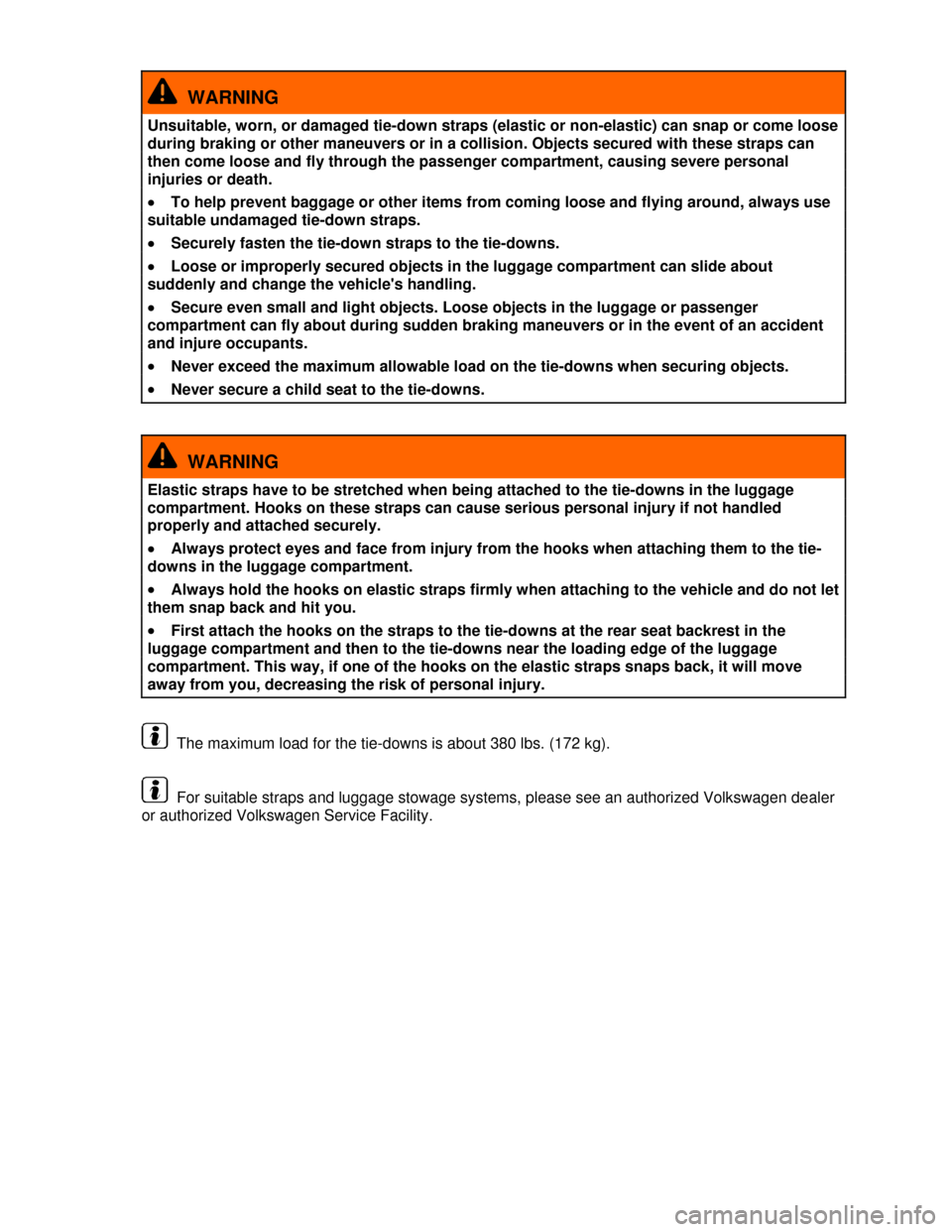
WARNING
Unsuitable, worn, or damaged tie-down straps (elastic or non-elastic) can snap or come loose
during braking or other maneuvers or in a collision. Objects secured with these straps can
then come loose and fly through the passenger compartment, causing severe personal
injuries or death.
�x To help prevent baggage or other items from coming loose and flying around, always use
suitable undamaged tie-down straps.
�x Securely fasten the tie-down straps to the tie-downs.
�x Loose or improperly secured objects in the luggage compartment can slide about
suddenly and change the vehicle's handling.
�x Secure even small and light objects. Loose objects in the luggage or passenger
compartment can fly about during sudden braking maneuvers or in the event of an accident
and injure occupants.
�x Never exceed the maximum allowable load on the tie-downs when securing objects.
�x Never secure a child seat to the tie-downs.
WARNING
Elastic straps have to be stretched when being attached to the tie-downs in the luggage
compartment. Hooks on these straps can cause serious personal injury if not handled
properly and attached securely.
�x Always protect eyes and face from injury from the hooks when attaching them to the tie-
downs in the luggage compartment.
�x Always hold the hooks on elastic straps firmly when attaching to the vehicle and do not let
them snap back and hit you.
�x First attach the hooks on the straps to the tie-downs at the rear seat backrest in the
luggage compartment and then to the tie-downs near the loading edge of the luggage
compartment. This way, if one of the hooks on the elastic straps snaps back, it will move
away from you, decreasing the risk of personal injury.
The maximum load for the tie-downs is about 380 lbs. (172 kg).
For suitable straps and luggage stowage systems, please see an authorized Volkswagen dealer
or authorized Volkswagen Service Facility.
Page 133 of 324

WARNING
Improper use of the trailer hitch can cause accidents and injuries. An improperly installed,
incorrect, or damaged trailer hitch can cause the trailer to separate from the towing vehicle
and cause serious personal injuries.
�x Only use an undamaged, properly mounted trailer hitch.
�x Never repair or modify the trailer hitch.
�x To reduce the risk of injury in rear-end collisions, and the risk to pedestrians and cyclists
when the vehicle is parked, always remove the ball mount when you are not towing a trailer.
�x Never install a “weight distributing” or “load equalizing” trailer hitch on your vehicle. The
vehicle was not designed for these kinds of trailer hitches. The trailer hitch attachment can
fail, causing the trailer to tear loose from the vehicle.
WARNING
Improper trailer towing can cause loss of vehicle control and serious personal injury.
�x Driving with a trailer and carrying heavy or large things can change the way the vehicle
handles, increase the distance it needs to stop safely, and cause accidents.
�x Always secure the load properly with suitable and undamaged straps so that the load will
not shift.
�x Always adapt your speed and driving to the heavier load and the weight distribution in the
vehicle. Take road, weather, traffic, and visibility conditions into account as well.
�x Reduce your speed even more than you otherwise would when going downhill and under
unfavorable load, weather, or wind conditions.
�x Trailers with a high center of gravity tip more easily than trailers with a low center of
gravity.
�x Always avoid sudden maneuvers and hard braking.
�x Be especially careful when passing other vehicles.
�x Reduce speed immediately if the trailer shows the slightest sign of swaying.
�x Never try to stop the swaying by accelerating.
�x Always obey speed limits. In some areas, the speed limits for vehicles towing trailers are
lower than for vehicles without trailers. Never drive faster than 50 mph (80 km/h); under
exceptional circumstances 60 mph (100 km/h), when towing a trailer. This applies even if the
local speed limit is higher.
If you are driving a new vehicle or a vehicle with a new or rebuilt engine, do not tow a trailer
during the break-in period, about 600 miles (1000 km) .
If you tow a trailer, your vehicle may need maintenance more often because of the extra load it
has to move.
When you are not towing, remove the trailer hitch ball. This helps keep the trailer hitch from
causing damage to your vehicle and to others if your vehicle is hit from behind.
Some models need a trailer hitch to tow or tow-start other vehicles. You may want to always
carry the ball mount in the vehicle after it has been removed. Be sure to stow it securely.
Page 135 of 324

WARNING
�x An improperly installed or incorrect trailer hitch can cause a trailer to separate from the
tow vehicle and cause serious personal injuries.
�x If you don't have to tow a trailer any more, remove the entire trailer hitch. Always seal all
bolt holes to prevent water and deadly exhaust fumes from getting into the vehicle.
NOTICE
�x If the trailer lights are not connected properly, the vehicle's electronics may be damaged.
�x If the trailer uses too much electricity, the vehicle's electronics may be damaged.
�x Never connect the electrical system for the trailer directly to the electrical connections for
the rear lights or to any other unsuitable power sources. Use only a suitable connector to
provide power to the trailer.
If you tow a trailer frequently, Volkswagen recommends having the vehicle serviced between the
regular maintenance and inspection intervals because of the extra load it has to pull.
Hitching up and connecting a trailer
�
Page 138 of 324
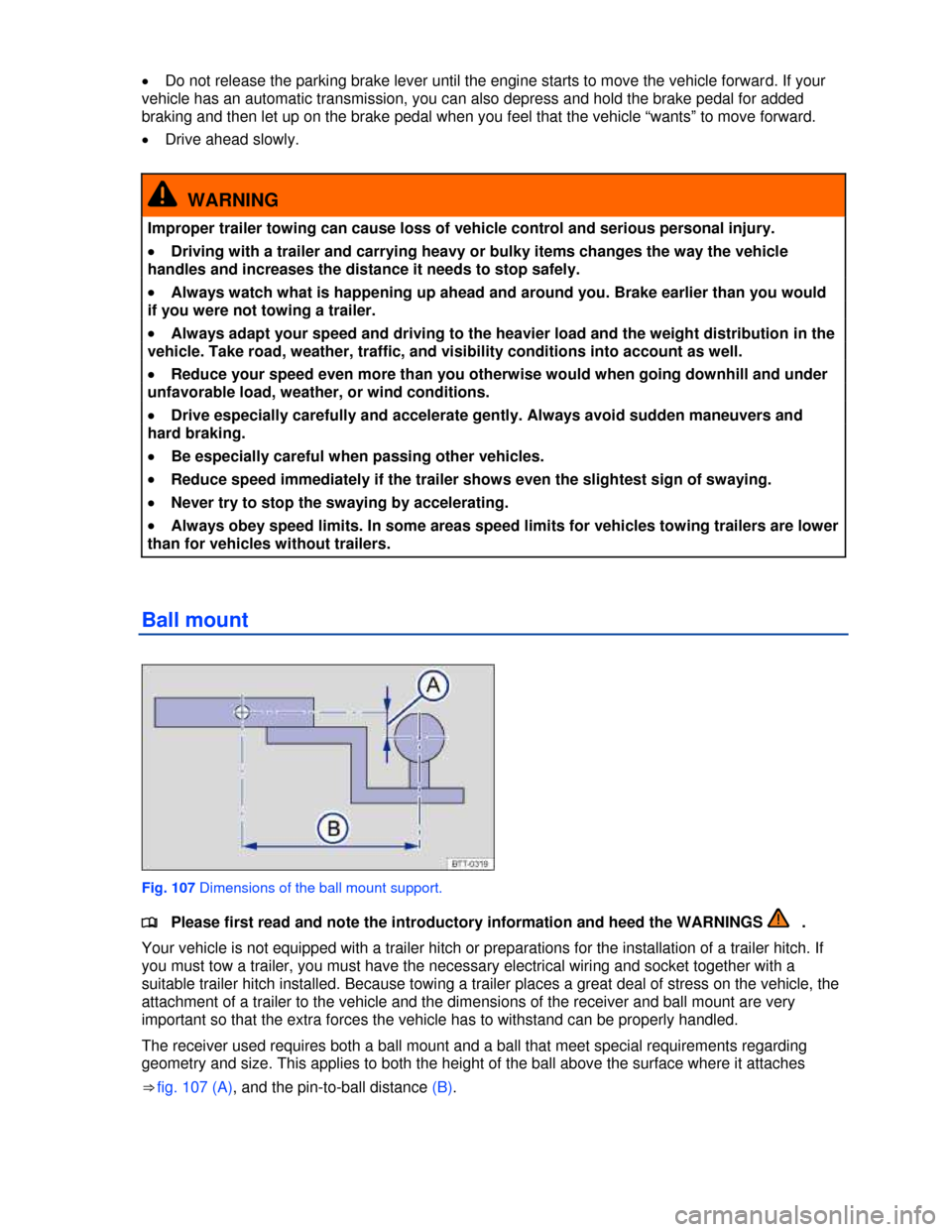
�x Do not release the parking brake lever until the engine starts to move the vehicle forward. If your
vehicle has an automatic transmission, you can also depress and hold the brake pedal for added
braking and then let up on the brake pedal when you feel that the vehicle “wants” to move forward.
�x Drive ahead slowly.
WARNING
Improper trailer towing can cause loss of vehicle control and serious personal injury.
�x Driving with a trailer and carrying heavy or bulky items changes the way the vehicle
handles and increases the distance it needs to stop safely.
�x Always watch what is happening up ahead and around you. Brake earlier than you would
if you were not towing a trailer.
�x Always adapt your speed and driving to the heavier load and the weight distribution in the
vehicle. Take road, weather, traffic, and visibility conditions into account as well.
�x Reduce your speed even more than you otherwise would when going downhill and under
unfavorable load, weather, or wind conditions.
�x Drive especially carefully and accelerate gently. Always avoid sudden maneuvers and
hard braking.
�x Be especially careful when passing other vehicles.
�x Reduce speed immediately if the trailer shows even the slightest sign of swaying.
�x Never try to stop the swaying by accelerating.
�x Always obey speed limits. In some areas speed limits for vehicles towing trailers are lower
than for vehicles without trailers.
Ball mount
Fig. 107 Dimensions of the ball mount support.
�
Page 139 of 324
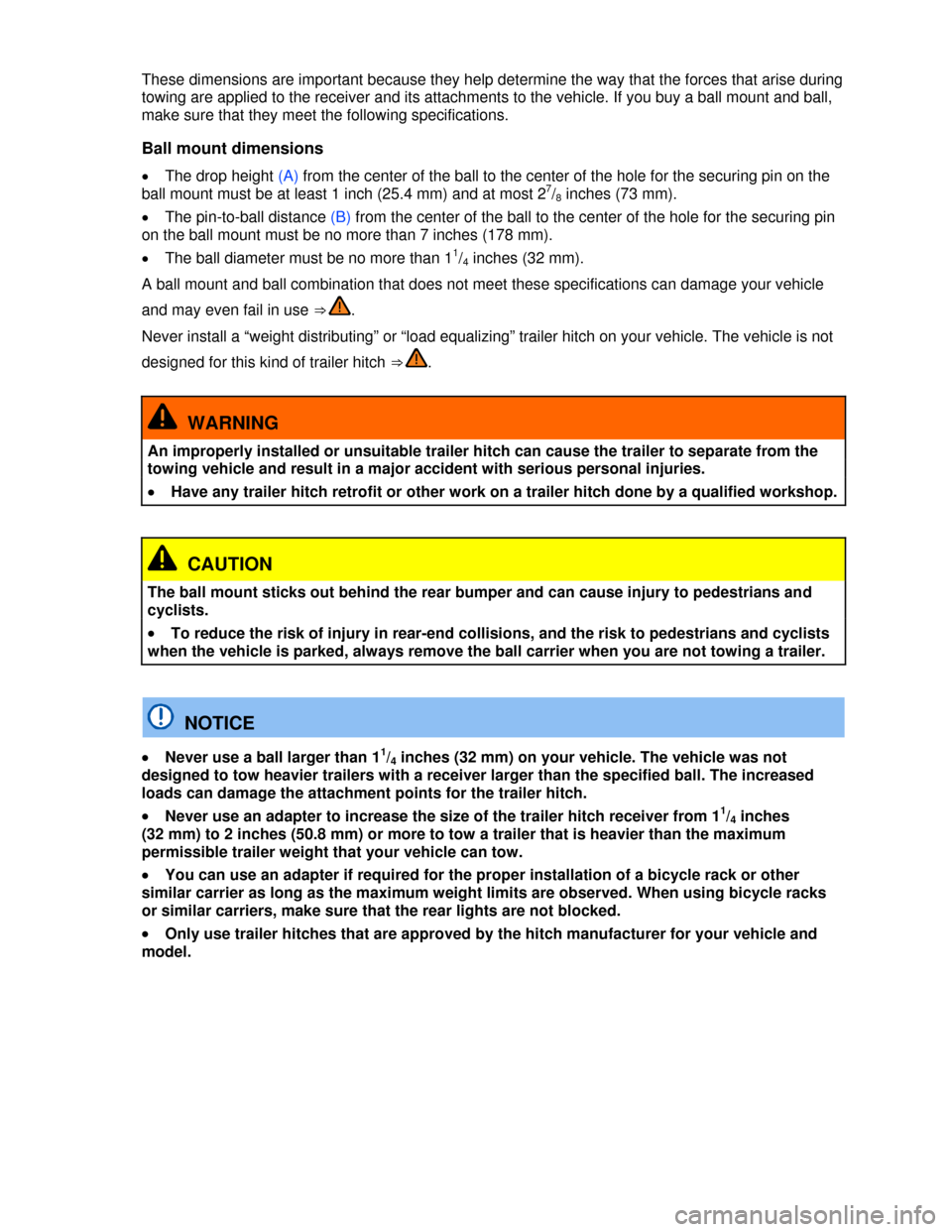
These dimensions are important because they help determine the way that the forces that arise during
towing are applied to the receiver and its attachments to the vehicle. If you buy a ball mount and ball,
make sure that they meet the following specifications.
Ball mount dimensions
�x The drop height (A) from the center of the ball to the center of the hole for the securing pin on the
ball mount must be at least 1 inch (25.4 mm) and at most 27/8 inches (73 mm).
�x The pin-to-ball distance (B) from the center of the ball to the center of the hole for the securing pin
on the ball mount must be no more than 7 inches (178 mm).
�x The ball diameter must be no more than 11/4 inches (32 mm).
A ball mount and ball combination that does not meet these specifications can damage your vehicle
and may even fail in use ⇒ .
Never install a “weight distributing” or “load equalizing” trailer hitch on your vehicle. The vehicle is not
designed for this kind of trailer hitch ⇒ .
WARNING
An improperly installed or unsuitable trailer hitch can cause the trailer to separate from the
towing vehicle and result in a major accident with serious personal injuries.
�x Have any trailer hitch retrofit or other work on a trailer hitch done by a qualified workshop.
CAUTION
The ball mount sticks out behind the rear bumper and can cause injury to pedestrians and
cyclists.
�x To reduce the risk of injury in rear-end collisions, and the risk to pedestrians and cyclists
when the vehicle is parked, always remove the ball carrier when you are not towing a trailer.
NOTICE
�x Never use a ball larger than 11/4 inches (32 mm) on your vehicle. The vehicle was not
designed to tow heavier trailers with a receiver larger than the specified ball. The increased
loads can damage the attachment points for the trailer hitch.
�x Never use an adapter to increase the size of the trailer hitch receiver from 11/4 inches
(32 mm) to 2 inches (50.8 mm) or more to tow a trailer that is heavier than the maximum
permissible trailer weight that your vehicle can tow.
�x You can use an adapter if required for the proper installation of a bicycle rack or other
similar carrier as long as the maximum weight limits are observed. When using bicycle racks
or similar carriers, make sure that the rear lights are not blocked.
�x Only use trailer hitches that are approved by the hitch manufacturer for your vehicle and
model.
Page 141 of 324
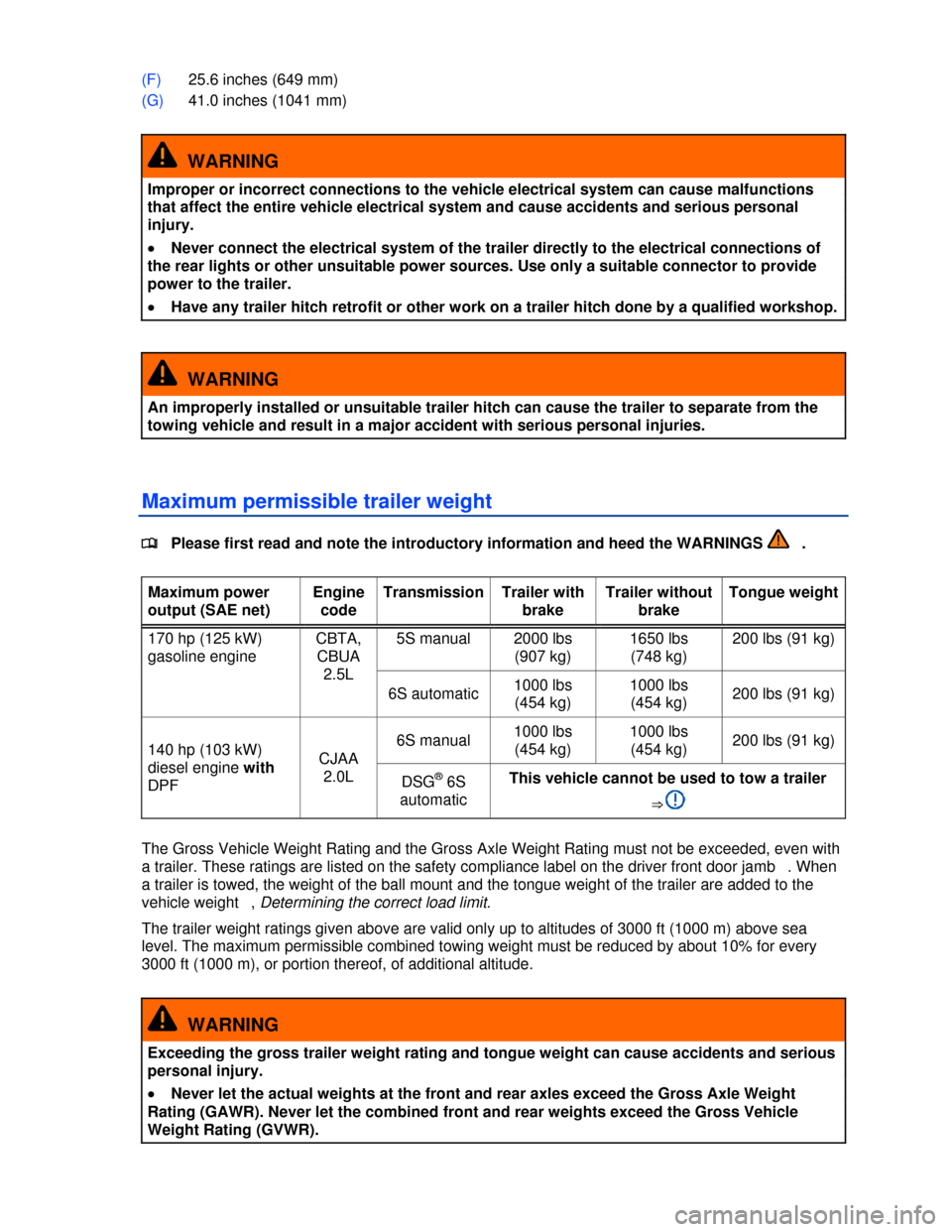
(F) 25.6 inches (649 mm)
(G) 41.0 inches (1041 mm)
WARNING
Improper or incorrect connections to the vehicle electrical system can cause malfunctions
that affect the entire vehicle electrical system and cause accidents and serious personal
injury.
�x Never connect the electrical system of the trailer directly to the electrical connections of
the rear lights or other unsuitable power sources. Use only a suitable connector to provide
power to the trailer.
�x Have any trailer hitch retrofit or other work on a trailer hitch done by a qualified workshop.
WARNING
An improperly installed or unsuitable trailer hitch can cause the trailer to separate from the
towing vehicle and result in a major accident with serious personal injuries.
Maximum permissible trailer weight
�
Page 151 of 324

�x Coat hooks on the center door pillars and on the overhead grab handles in the rear.
�x Shopping bag hooks in the luggage compartment .
WARNING
Hanging clothes may limit visibility and cause accidents and severe personal injuries.
�x Always hang clothes so that they do not limit visibility.
�x Always use the built-in coat hooks only for lightweight clothing. Never leave any heavy or
sharp-edged items in the pockets that may interfere with airbag deployment and can cause
personal injury in a collision.
Page 159 of 324
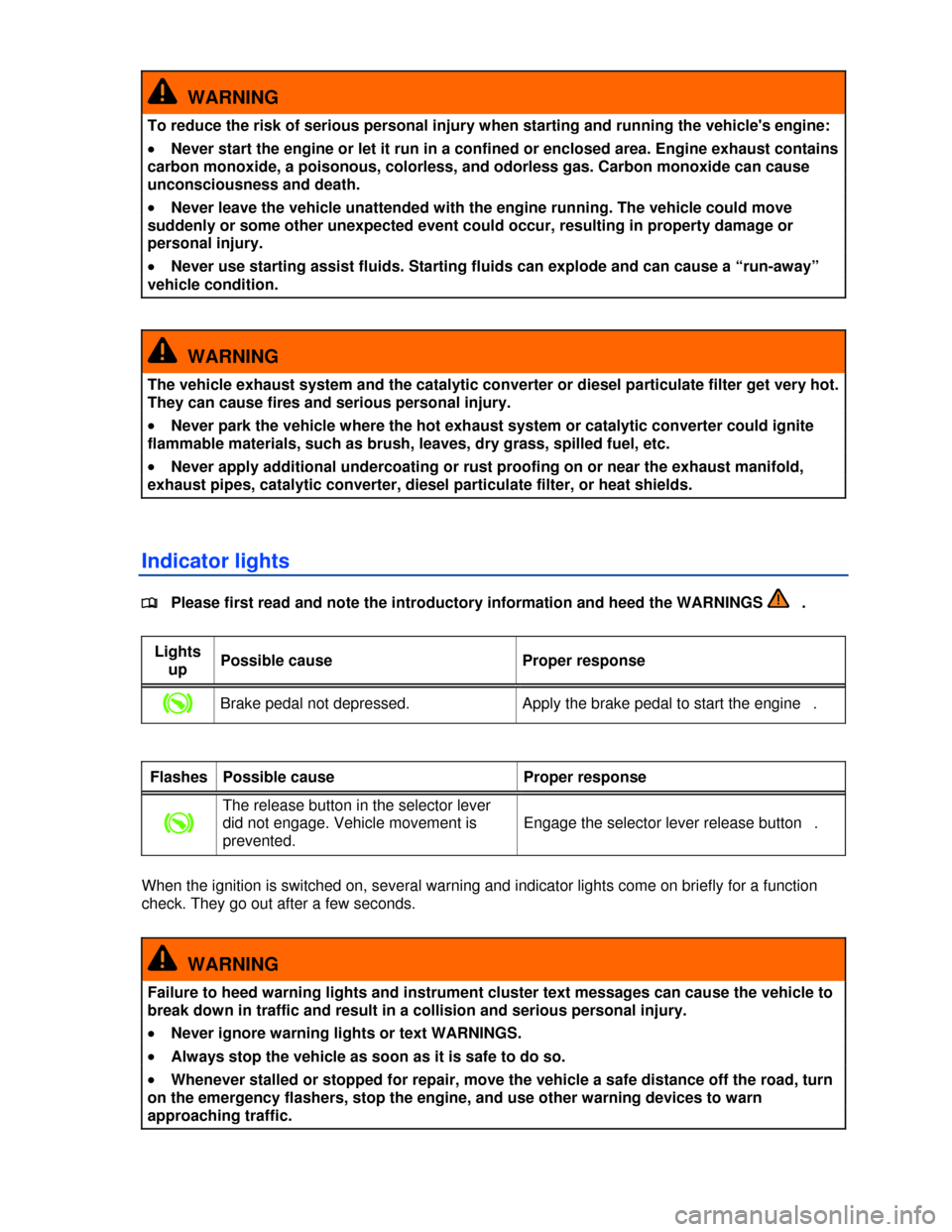
WARNING
To reduce the risk of serious personal injury when starting and running the vehicle's engine:
�x Never start the engine or let it run in a confined or enclosed area. Engine exhaust contains
carbon monoxide, a poisonous, colorless, and odorless gas. Carbon monoxide can cause
unconsciousness and death.
�x Never leave the vehicle unattended with the engine running. The vehicle could move
suddenly or some other unexpected event could occur, resulting in property damage or
personal injury.
�x Never use starting assist fluids. Starting fluids can explode and can cause a “run-away”
vehicle condition.
WARNING
The vehicle exhaust system and the catalytic converter or diesel particulate filter get very hot.
They can cause fires and serious personal injury.
�x Never park the vehicle where the hot exhaust system or catalytic converter could ignite
flammable materials, such as brush, leaves, dry grass, spilled fuel, etc.
�x Never apply additional undercoating or rust proofing on or near the exhaust manifold,
exhaust pipes, catalytic converter, diesel particulate filter, or heat shields.
Indicator lights
�